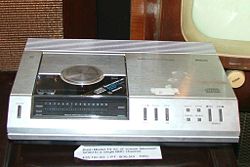CD player
A CD player is a device that can read the binary data on a CD (compact disc) and turn that into sound waves.
A CD player has a laser and an optical sensor. A CD has tracks and bumps on the tracks. The CD player passes a laser beam along the track of the CD. The areas that are reflected (without the bumps) are 1s to the player and the areas that are reflected (with the bumps) are 0s to the player. When the 1's and 0's are added to the CD a complicated coding is used that enables error corrections to prevent the CD "skipping" in the event of a small scratch. The CD player converts the series of 1's and 0's into sound waves by sending a varying voltage into an amplifier which then drives a speaker. The conversion of digital data into an analogue signal is achieved through the use a matrix (maths not the movie), imaginary numbers and trigonometric functions.
CD Player Media
Sony CDP-101 from 1982, the first commercially released CD player for consumers
Philips CD100 from 1983, the first commercially released CD player in the USA and Europe
This disc is highly corroded. The error correction cannot correct all errors. Two minutes can be played, however.
A JVC FS-SD5R CD player from the 1990s with a transparent plastic cover and blue backlight
A 1980s-era Denon CD player with the chassis cover removed to show the electronic and mechanical components.
An example of a Pioneer CD player's tray closing.
Related pages
| Wikimedia Commons has media related to Lua error in Module:Commons_link at line 62: attempt to index field 'wikibase' (a nil value).. |









